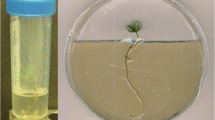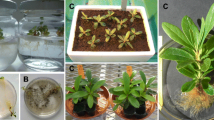Abstract
Hygrophorus olivaceoalbus has long been known as an ectomycorrhizal fungus, formerly designated with the artificial binomen Piceirhiza gelatinosa. Recently, it has been found to be abundant and very frequent under double ambient ozone free air fumigation of mature Norway spruce trees. As it has already been reported that this fungus can form intercellular hyphae within the root meristem, a more detailed study was performed to clarify its type of root colonization. The present study not only revealed intercellular hyphae within the meristematic zone but also intracellular hyphae within root cortex cells which grow towards and into large tannin droplets—phenolic compounds usually deposited as defensive aids—to finally fill them completely. The hyphal assemblages become globular which at first sit as separated hyphal balls within cells still containing cytoplasm. Later on, they are apparently released from the root cells, presumably as microsclerotia for dispersal of the species. Old ectomycorrhizae (ECM) show an apical pore, and later a large orifice of a tube-like cylinder formed by the thick, persistent hyphal mantle. The root tissue is progressively degrading towards proximal parts. Disintegrating root cells apparently liberate the microsclerotia through the orifice. Further studies have to find out the mechanism by which the microsclerotia are liberated and whether they operate as asexual propagules and lastly how and by whom they are propagated. As these ECM are found under ozone stress, and with identical features at higher altitudes, stress impact on trees might be the causative agent for the high frequency and abundance of Hygrophorus olivaceoalbus ECM.







Similar content being viewed by others
References
Agerer R (1991) Characterization of ectomycorrhiza. In Norris JR, Read DA, Varma AK (eds) Techniques for the study of mycorrhiza. Methods in Microbiology, vol. 23, Academic, London, pp 25–73
Agerer R (2001) Exploration types of ectomycorrhizae. A proposal to classify ectomycorrhizal mycelial systems according to their patterns of differentiation and putative ecological importance. Mycorrhiza 11:107–114
Agerer R, Rambold G (2004–2011) [first posted on 2004-06-01; most recent update: 2011-01-10]). DEEMY – An Information System for Characterization and Determination of Ectomycorrhizae. www.deemy.de – München, Germany
Agerer R, Schloter M, Hahn C (2000) Fungal enzymatic activity in fruitbodies. Nova Hedwig 71:315–336
Agerer R, Christan J, Mayr C, Hobbie E (2010) Isotopic signatures and trophic status of Ramaria. Mycol Prog. doi:10.1007/s11557-010-0726-x
Berg B, Gronbach E (1989) Piceirhiza gelatinosa. In: Agerer (ed) Colour Atlas of Ectomycorrhizae, plate 30. Einhorn, Schwäbisch Gmünd
di Marino E, Montecchio L, Agerer R (2008) Hygrophorus penarius L. + Fagus sylvatica L. Descr Ectomyc 11/12:77–82
Gronbach E (1988) Charakterisierung und Identifizierung von Ektomykorrhizen in einem Fichtenbestand mit Untersuchungen zur Merkmalsvariabilität in sauer beregneten Flächen. Bibliotheca Mycologica, vol 125. Cramer, Berlin
Gronbach E, Agerer R (1986) Charakterisierung und Inventur der Fichten-Mykorrhizen im Höglwald und deren Reaktion auf saure Beregnung. Forstwiss Cent Bl 105:329–335
Häberle K-H, Werner H, Fabian P, Pretzsch H, Reiter I, Matyssek R (1999) ‘Free-air’ ozone fumigation of mature forest trees: a concept for validating AOT40 under stand conditions. In: Fuhrer J, Achermann B (eds) Critical Level for Ozone – Level II. Swiss Agency for the Environment, Forests and Landscape (SAEFL), Berne, pp 133–137
Haug I (1987) Licht- und elektronenmikroskopische Untersuchungen an Mykorrhizen von Fichtenbeständen im Schwarzwald. Dissertation, University of Tübingen
Haug I (1989) Intercellular infection in the meristematic region of "Piceirhiza gelatinosa" mycorrhizas. New Phytol 111:203–207
Haug I, Pritsch K (1992) Ectomycorrhizal types of spruce (Picea abies (L.) Karst.) in the Black Forest. A microscopical atlas. Kernforschungszentrum Karlsruhe, PEF-Ber, pp 1–89
Herrmann WM (1995) Tripartite symbiotic associations in nitrogen-fixing plants of Mount Changbai Nature Reserve in northeast China. Dissertation, LMU München
Hobbie EA, Agerer R (2010) Nitrogen isotopes in ectomycorrhizal sporocarps correspond to belowground exploration types. Plant Soil 327:71–83
Hobbie EA, Mackus SA, Shugart HH (1999) Insights into nitrogen and carbon dynamics of ectomycorrhizal and saprotrophic fungi from isotopic evidence. Oecologia 118:353–360
Kreutzer K, Bittersohl J (1986) Untersuchungen über die Auswirkungen des sauren Regens und der kompensatorischen Kalkung im Wald. Zielsetzung, Anlage und bisherige Durchführung des Freilandexperimentes Höglwald einschließlich begleitender Untersuchungen. Forstwiss Cent Bl 105:273–282
Lindahl BD, Ihrmark K, Boberg J, Trumbore SE, Högberg P, Stenlid J, Finlay RD (2006) Spatial separation of litter decomposition and mycorrhizal uptake in a boreal forest. New Phytol 173:611–620
Nunn AJ, Reiter IM, Häberle K-H, Werner H, Langebartels C, Sandermann H, Heerdt C, Fabian P, Matyssek R (2002) “Free-air” ozone canopy fumigation in an old-growth mixed forest: concept and observations in beech. Phyton 42:105–109
Pretzsch H, Kahn M, Grote R (1998) Die Fichten-Buchen-Mischbestände des Sonderforschungsbereiches “Wachstum oder Parasitenabwehr?” im Kranzberger forst. Forstwiss Cent Bl 117:241–257
Smith SE, Read DJ (2008) Mycorrhizal symbiosis, 3rd edn. Academic, San Diego
Taylor AFS, Fransson PM, Högberg P, Högberg MN, Plamboeck AH (2003) Species level patterns in 13C and 15N abundance of ectomycorrhizal and saprotrophic fungal sporocarps. New Phytol 159:757–774
Thiers B (2011, continuously updated) Index Herbariorum: A global directory of public herbaria and associated staff. New York Botanical Garden’s Virtual Herbarium. http://sweetgum.nybg.org/ih/
Trudell SA, Rygiewicz PT, Edmonds RL (2004) Patterns of nitrogen and carbon stable isotope ratios in macrofungi, plants and soils in two old growth conifer forests. New Phytol 164:317–335
Weigt R, Verma R, Raidl S, Agerer R (2011) Exploration type specific standard values of extramatrical mycelium - a step towards assessing ectomycorrhizal space occupation and biomass in natural soil. Mycol Prog. doi:10.1007/s11557-011-0750-5
Werner H, Fabian P (2002) Free-air fumigation of mature trees. Environ Sci Poll Res 9:117–121
Zeller B, Brechet C, Maurice J-P, Le Tacon F (2007) 13C and 15N isotopic fractionation in trees, soils and fungi in a natural forest stand and a Norway spruce plantation. Ann For Sci 64:419–429
Acknowledgment
The skilful preparations of the sections by my technicians, Edi Marksteiner and Claudia Bubenzer-Hange, are warmly acknowledged. The help of my PhD student Rita Verma with counting ECM of the Kranzberger Forest plots, calculating absolute frequency and relative abundance and for critically reading the manuscript, and the help of my PhD student Sebastian Gardt for compiling serial sections of the microsclerotia is highly appreciated. Last but not least, I thank Deutsche Forschungsgemeinschaft (DFG) for financial support of our project B7 of SFB 607.
Author information
Authors and Affiliations
Corresponding author
Rights and permissions
About this article
Cite this article
Agerer, R. Asexual reproduction of Hygrophorus olivaceoalbus by intracellular microsclerotia in root cells of Picea abies – A winner of ozone stress?. Mycol Progress 11, 425–434 (2012). https://doi.org/10.1007/s11557-011-0757-y
Received:
Revised:
Accepted:
Published:
Issue Date:
DOI: https://doi.org/10.1007/s11557-011-0757-y




